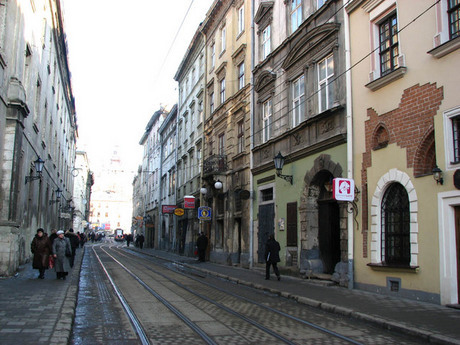Ruska Street
The ensemble of Ruska Street (16-20th centuries) includes residential houses and administrative buildings of ancient Lviv. The earliest mention of the Street is in 1472. Throughout the centuries it was populated mostly by Ukrainians, called in the Galicia of that time "Ruthenians". Hence the name of the Street - Ruska.
Since the 14th century Solyanykiv Street (‘Salt Traders’ Street’ in Ukrainian) was the centre of Ukrainian Lviv, so called because its inhabitants actively traded salt, often leaving for salterns in the Pre-Carpathians, some of the few in Europe in those times. This street was later renamed Ruska Street (Ruthenian Street), as this was where Ukrainians, called Ruthenians in ancient times, would settle. This district remained a political, economic, and cultural centre for Ukrainians for many centuries.
Building No. 2 in Ruska Street (15-17th centuries) is one of the oldest stone buildings in Lviv. The building retained elements of Gothic architecture, as evident in the first floor vaulting and the open profiles revealing ancient brick masonry. On the side of Serbska Street the house façade was reinforced with thick buttresses.
Building No. 4, erected in the 16th century, has retained its original planning structure and Gothic cross-vaulting. The white masonry portal also dates back to the 16th century, as does the stone lion’s head in the courtyard above the brick arch; the lion bears a bunch of grapes in its mouth, evidence that the building used to accommodate a winery. The white carved stone window frames have also been preserved with their original inscriptions in Old Armenian (Grabar), indicating that the establishment was owned by the Armenian Wartanowicz family. At present the building houses the GerdanArt Gallery, and through the courtyard one comes across a very original coffee shop called “The Blue Bottle” which is decorated in old Austrian fashion.
House No 7. The complex of the Assumption Church is one of the finest examples of Renaissance architecture in Lviv. The Church was constructed in 1591-1629 to the design of Paul of Rome. The bell Tower known as Kornyakt Tower (after Constantine Kornyakt who funded its construction) was completed in 1578 under the architect Peter of Barbone. The Chapel of Three Prelates, constructed in 1578-90, amazes the viewer with the logic of its design and the intricate stone carving decorating the portal. The basement of the Church served as a burial place, where Ivan Pidkova and Constantine Kornyakt were buried.
The Stavropigia fraternity whose activities were linked with the church since the 16th century was the religious, political and educational centre of the Ukrainian community in Lviv. The school set up by the fraternity was famous far beyond Galicia. The Charter of the school, dating from 1586, was one of the first documents of this type in Europe; the school professor Joankyj Volokovych wrote one of the earliest examples of Ukrainian poetry; and the school graduate Pamvo Berynda is known as the author of the first Ukrainian encyclopaedia.
House No 8 dates from 1740. The reliefs on the facade portray the symbols of trade. The House incorporates a 16th century portal.
House No 10 dates back to the 17th century. The portal and some details of the interior have been preserved since the 16th century.
House No 20 was built for the Dniester Insurance Company in 1907 in the Art Nouveau style. Ukrainian folk ornament with inlaid ceramic tiles are used for the decoration of the facade.
Ruska Street is yet another example of the rich history of the city. The easiest way to get to Lviv is via airplane. There are daily flights to Lviv and Kiev from Europe and North America.




